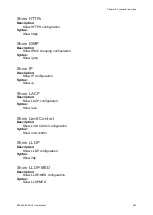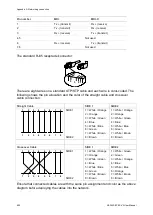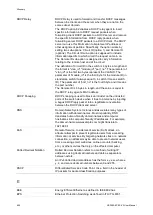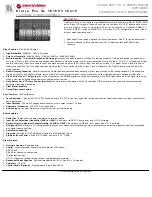
Glossary
496
NS3552-8P-2S-V2 User Manual
DHCP Relay
DHCP Relay is used to forward and transfer DHCP messages
between the clients and the server when they are not on the
same subnet domain.
The DHCP option 82 enables a DHCP relay agent to insert
specific information into DHCP request packets when
forwarding client DHCP packets to a DHCP server and remove
the specific information from DHCP reply packets when
forwarding server DHCP packets to a DHCP client. The DHCP
server can use this information to implement IP address or
other assignment policies. Specifically, the option works by
setting two sub-options: Circuit ID (option 1) and Remote ID
(option2). The Circuit ID sub-option is supposed to include
information specific to which circuit the request came in on.
The Remote ID sub-option is designed to carry information
relating to the remote host end of the circuit.
The definition of Circuit ID in the switch is 4 bytes in length and
the format is "vlan_id" "module_id" "port_no". The parameter of
"vlan_id" is the first two bytes represent the VLAN ID. The
parameter of "module_id" is the third byte for the module ID (in
standalone switch it always equal 0, in switch it means switch
ID). The parameter of "port_no" is the fourth byte and it means
the port number.
The Remote ID is 6 bytes in length, and the value is equal to
the DHCP relay agent’s MAC address.
DHCP Snooping
DHCP snooping is used to block an intruder on the untrusted
ports of the switch device when it tries to intervene by injecting
a bogus DHCP reply packet into a legitimate conversation
between the DHCP client and server.
DNS
Domain Name System. It stores and associates many types of
information with domain names. Most importantly, DNS
translates human-friendly domain names and computer
hostnames into computer-friendly IP addresses. For example,
the domain name www.example.com might translate to
192.168.0.1.
DoS
Denial of Service. In a denial-of-service (DoS) attack, an
attacker attempts to prevent legitimate users from accessing
information or services. By targeting network sites or a network
connection, an attacker may be able to prevent network users
from accessing email, web sites, online accounts (banking,
etc.), or other services that rely on the affected computer.
Dotted Decimal Notation
Dotted Decimal Notation refers to a method of writing IP
addresses using decimal numbers and dots as separators
between octets.
An IPv4 dotted decimal address has the form x.y.z.w, where x,
y, z, and w are decimal numbers between 0 and 255.
DSCP
Differentiated Services Code Point. It is a field in the header of
IP packets for packet classification purposes.
E
EEE
Energy Efficient Ethernet as defined in IEEE 802.3az.
EPS
Ethernet Protection Switching as defined in ITU/T G.8031.
Summary of Contents for NS3552-8P-2S-V2
Page 1: ...NS3552 8P 2S V2 User Manual P N 1073552 EN REV B ISS 25JAN19 ...
Page 41: ...Chapter 3 Switch management NS3552 8P 2S V2 User Manual 39 ...
Page 73: ...Chapter 4 Web configuration NS3552 8P 2S V2 User Manual 71 ...
Page 147: ...Chapter 4 Web configuration NS3552 8P 2S V2 User Manual 145 ...
Page 511: ......














































